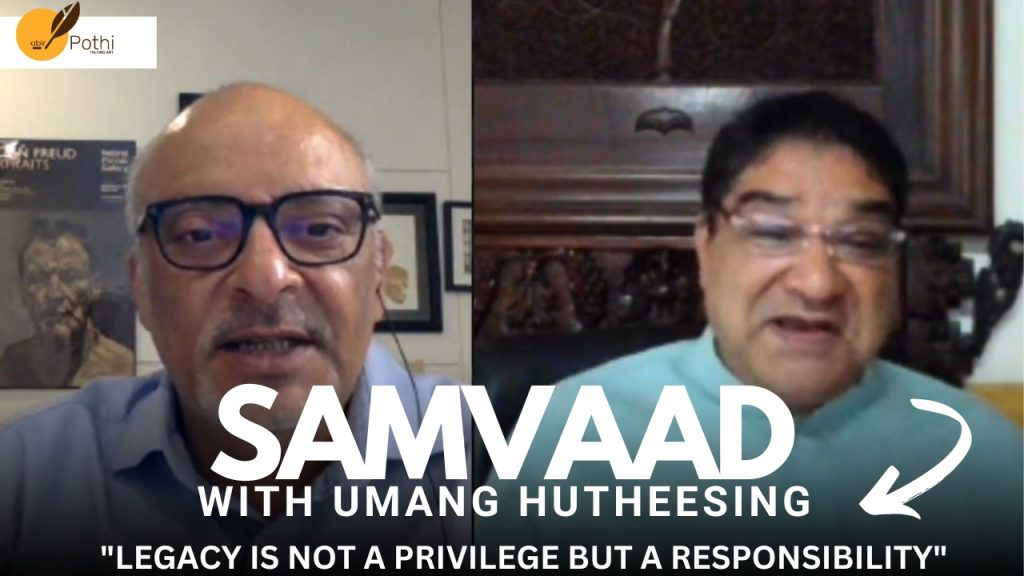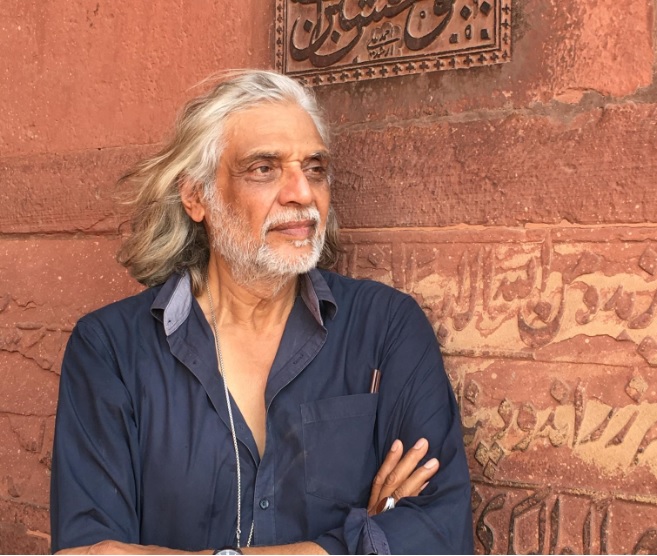Welcome to Samvaad, where art meets conversation, and inspiration knows no bounds. Here we engage in insightful conversations with eminent personalities from the art fraternity. Through Samvaad, Abir Pothi aims to create a platform for thought-provoking discussions, providing readers with an exclusive glimpse into the creative processes, inspirations, and experiences of these creative individuals. From curating groundbreaking exhibitions to pushing the boundaries of artistic expression, our interviews shed light on the diverse perspectives and contributions of these art luminaries. Samvaad is your ticket to connect with the visionaries who breathe life into the art world, offering unique insights and behind-the-scenes glimpses into their fascinating journeys.
This is part 2 of the Samvaad between Nidheesh Tyagi from Abir and Umang Hutheesing, the founder and president of the Hutheesing heritage foundation. Umang Hutheesing is on the governing board of the Ahmedabad Education Society, a managing trustee of the Hutheesing Visual Art Centre, and most importantly is the president and fifth generation of Hutheesing to manage the Hutheesing Design Company and Studio from the very same historic location, Jaising bhai-ni-wadi. He is also the founder and president of the Hutheesing heritage foundation which has restored the Hutheesing Haveli and preserves the Hutheesing art collection. He has collaborated with the international foundation Musée Yves Saint Laurent in Paris and the National Museum of Bahrain, the Baroque Museum in Mexico, the Miho Museum in Japan, and the Chhatrapati Shivaji Vaastu Sangrahalya in Mumbai, where he has exhibited over 300 pieces showcasing the cultural heritage designed by him from the Hutheesing collection.
Nidheesh: Almost everywhere in the world yeah. So, what was a thing in them? I mean this is a bit strange because we do not find it in other cities in India that this amazing amount of evolutionary approach as well as hugely philanthropic kind of spirit which is with these textile families of Ahmedabad we see. What do you think about the factors which let all of this happen?
Umang: I will tell you. So, there’s an interesting story, not a story but a fact the people of India and the world should know. The three important cities of art, architecture, and design were not built by emperors or kings but by their people and two cities of these are very well known. Can you tell me which two cities in the whole world you put on top in terms of art, design, culture, and architecture?
Nidheesh: in India or in the world?
Umang: globally.
Nidheesh: no, I do not know
Umang: you do know. Florence,
Nidheesh: okay yeah.
Umang: Venice
Nidheesh: hmm and Ahmedabad
Umang: yes. And do you know what is common in these three cities? That neither Venice had a king, merchants governed it, Florence never had a king, the Medici’s were a trading family and Ahmedabad did not have a king. It was the mahajans of Ahmedabad who ruled and governed it. So, the merchants of Venice, Medici of Florence, and mahajans of Ahmedabad built the important UNESCO world heritage cities which were known for art, design, and culture and the backbone of this was because they were trained in textiles and jewellery. The resources came intact because they were community-led and driven. It did not go to enrich the king’s treasury; it enriched the city, its institutions, and art. That tradition continues, and therefore Ahmedabad today is India’s first UNESCO-declared world heritage city.
Nidheesh: True, yeah.
Umang: Before Varanasi, Jaipur, or Delhi, I mean the entire country.
Nidheesh: True.
Umang: One of the symbols of the UNESCO heritage city Ahmedabad is the Hutheesing temple, which was built during this time frame with refugees. From scratch, started a design company that went on to execute those things in 1881. In 1900 when Paris hosted the world expo, we were still in British rule; we won nine gold medals as the finest design firm in the world.
Nidheesh: wow
Umang: Yes. And people don’t know that history.
Nidheesh: yes. They are not aware of all these events. So, what are you doing currently as a custodian of this inheritance and heritage? How do you manage and keep a balance between your kind of work as well?
Umang: you know, with legacy, when people talk about the legacy, legacy is not just a privilege, but it is a responsibility.
Nidheesh: absolutely
Umang: that responsibility has been learned from childhood. We learn as we are growing up, parents and grandparents tell stories about each item, various stories, why is it important, why we preserve, you know when your responsibilities come before you.
Nidheesh: true.
Umang: you know because this does not belong to me, this belongs to the future generations to come. So, for example, whatever we have at the back behind me is a beautifully carved piece, and it was shown at the Paris expo and even at the Chatrapati Sivaji museum, got many world views. I am sitting in my office where the five generations of Hutheesing worked on the table, not the chair because the chairs have been changed. But, same desk, same office, same studios, same space. Not only the architecture but also the design.
Nidheesh: that is another question that I was willing to ask about Ahmedabad’s experiment with different architects and their forms, which again, you and your family have been a part of, so you know.
Umang: very much. See, it was very important to have a global perspective. We have an Indian heart but a global vision. And that must continue, that was the part of our education. Our grandparents even in the 1920s, the women of our families went to Oxford, Harvard and one of the sisters of my grandfather did Ph.D. in social psychology from Zurich University in 1922.
Nidheesh: wow
Umang: and my great-grandmother set up a cook in our house there, and they taught other Swiss families how Gujarati and Indian vegetable food, their restaurant of Gujarati food still exists from that time till now in Zurich.
Nidheesh: The cultural connections.
Umang: yes, absolutely. So, look at that time she had to go by shape because a young girl was going, a house was set up, and it happened during pre-independence in British times. So, when they came back with the awareness, this was the time when communication was actually started, books were being printed with color, and there was a new movement of global integration. The first integration was the silk route, where they send silk from China to Venice to make velvets. And those velvets were used by the Ottoman empires and the Mughal kings. That was international trade and design. It became even more powerful in the 19th century during the industrial revolution.
Nidheesh: and then the textile thing happened in Ahmedabad.
Umang: yes, and Ahmedabad became the Manchester of the east. And with that level of exposure, and movement of looking forward to creating industrial wealth. Also, came creating new experiences in art and design. Industrial products were also designed.
Nidheesh: absolutely
Umang: and therefore, NID was set up under the ministry to create designers for Indian industries. So, it was forward-thinking.
Nidheesh: absolutely, amazingly forward.
Umang: and because of the industrial revolution, we are able to design products for the industry. And therefore, the prime minister’s make in India is designed in India. So, this is what we believe in. Throughout time, we just not focused on production but the design. Before a product is produced, it has to be designed. A design requires research and development; production doesn’t.
Transcribed By Abhishek Dixit.





